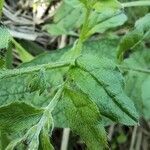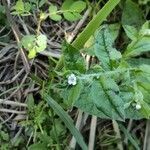Annual, with numerous stems and subappressed hairs that are only more patent in the petioles and leaf margins. Stems prostrate, 8-25 cm long, slender, simple or nearly simple. Basal leaves soon dry and often vanishing, stem leaves 15-30 by 3-8 mm, decreasing in size upwards, with wavy margin and acute apex, the lower ones stalked, ovate-lanceolate to lanceolate, the upper ones sessile, lanceolate. Inflorescence leafy, leaves 7-8 mm by c. 2 mm. Flowers not strictly axillary; pedicels 3-5 mm long. Calyx c. 2 mm long, with linear-lanceolate lobes. Corolla c. 2.5 mm long, salver-shaped, tube shorter than calyx, lobes 5, rounded, explanate; fornices 5, trapeze-shaped, emarginate at apex. Pistil: style short, stigma capitate. Nutlets 1-1.2 mm long. Fig. 1.


